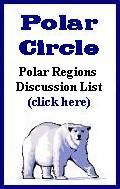|
|
|
 |
 |
 |
| romanticized notion of the Explorer: a daring and heroic figure who braved hardship and danger in the most remote regions of the earth...and lived to return and tell his tale--often greatly embellished--to eager readers of newspapers and books. |
| |
| In 1897 while other adventurers were struggling to set new records by gaining a mile or two more over the surface of the polar ice pack that surrounds the north pole, a Swedish engineer, Salomon August Andrée, conceived a daring, and well publicized, plan for flying to the north pole in a hydrogen-filled balloon. Andrée and his two companions disappeared somewhere over the ice pack north of Spitsbergen (now Svalbard), Norway. Their fate remained unknown for thirty-three years until a 1930 scientific expedition discovered their remains on a small polar island, thus adding to the already prevalent mystery and allure of the "Frozen North." |
| |
| Some ten years later an American journalist, Walter Wellman, attempted to follow in Andrée's footsteps by flying a somewhat more reliable hydrogen-filled dirigible, or steerable airship. Wellman flew roughly 30 miles out over the polar ice-pack in 1909 before turning back and abandoned his plans of flying to the north pole when both Frederick A. Cook and Robert E. Peary announced that each claimed to have reached the north pole. |
| |
| But these two flights--neither of which was successful--gained worldwide attention and highlighted the possibility that the vast polar regions could best be explored by air. The Historic Flights section details ten flights, by balloon, airship and airplane, in the forty-two years from 1897, the year of the Andrée balloon flight, to 1939 and the start of World War II. By the end of World War II, advancements in aviation technology had made flights over the top of the world almost routine and the pioneering efforts of exploring the north polar regions by air were at an end. |
| |
| |
| The Polar Regions section of this site describes the vast area lying north of 80ºN and encompassing the North Pole. Three additional sections, longitude and latitude, the sun in high latitudes, magnetic north-the wandering pole, and polar navigation complete the Polar Regions section. |
| |
| Ten Historic Flights chronicles the aerial exploration of the polar regions, 1897-1939, in historic flights and polar aviation firsts and seldom seen photos. |
| More Vintage Photos contains some additional rarely seen photos from the Golden Age of polar aviation. |
| An extensive Bibliography of polar aviation literature covering the period 1897-1939, completes the Aerial Exploration section. |
| |
| A Maps section contains maps of the polar regions and of the routes of historic flights. |
|
| A Linkpage provides links to other sites that contain additional information on subjects pertaining to the exploration of the polar regions. |
| |
| FAQs (frequently asked questions) provides additional information about the PolarFlight site. |
| |
| Finally, The North Pole Controversy details the longstanding dispute over which man, Frederick A. Cook or Robert E. Peary--if either one--was first to reach the North Pole. |
|
 |












